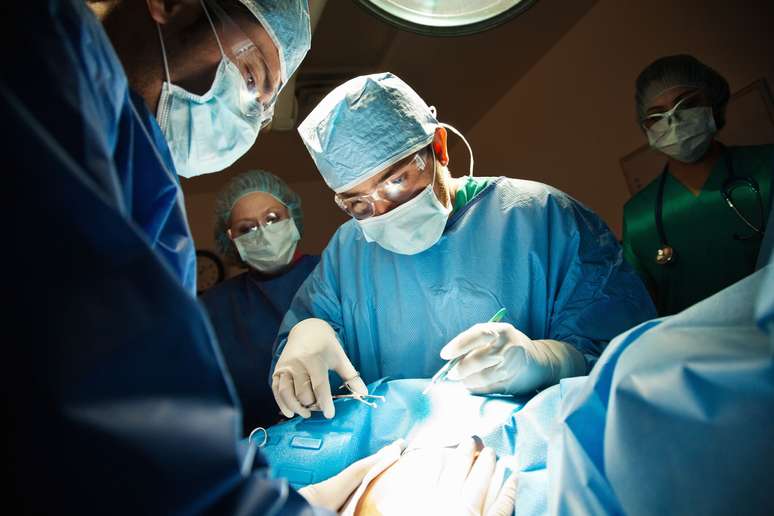Although it is a safe procedure, when properly indicated, surgery requires specific care.
When someone has to undergo surgery, the person is expected to have a smooth recovery, rest for a period, and not exert any effort so soon, right? In the case of a caesarean section, however, the story is not quite like that. Not only is the mother unable to rest as she should, but she also has a child to look after, feed, soothe… Even if it is safe, if well indicated and done by competent medical teams, in good hospitals, it is a surgical procedure and, therefore, may involve risks and complications.
html[data-range=”xlarge”] figure image img.img-b334e39d4235398e074dadaa5013d063l268pkzp { width: 774px; height: 524px; }HTML[data-range=”large”] figure image img.img-b334e39d4235398e074dadaa5013d063l268pkzp { width: 548px; height: 371px; }HTML[data-range=”small”] figure image img.img-b334e39d4235398e074dadaa5013d063l268pkzp, html[data-range=”medium”] figure image img.img-b334e39d4235398e074dadaa5013d063l268pkzp { width: 564px; height: 382px; }
“It’s the most performed surgery in the world,” says gynecologist and obstetrician Wagner Hernandez, a specialist in twin and high-risk pregnancies. In 2022, 57.7% of births in Brazil occurred by caesarean sectionaccording to the latest data released by the Ministry of Health – the number is almost four times higher than the rate recommended by the World Health Organization (WHO), which is 15%.
Even if it happens many times every day, in almost every corner of the world, caesarean sections require treatment. No, it’s not “just a little cut”. “We cut seven layers to get to the baby”explains Hernandez.
Cesarean sections
“In order: first the skin is incised. Then, the subcutaneous tissue, which would be the fat. Next, we open two aponeuroses, which are the tissues that connect the muscle to the bones. Next, we separate the rectus abdominis (the muscle that forms ‘buds’ in the belly) – this part is not cut, but opened in half. Next comes the parietal peritoneum, a layer that protects the intestines, the visceral peritoneum, which is like another layer that covers the organs and, only then, do we get to the uterus”, explains the doctor. Ufa! Complex, right?
The time it takes to do all of this varies, depending on a number of factors. For example: whether or not this is the woman’s first C-section, whether she has had previous abdominal operations, whether or not she is obese… There is also the question of the professional who is doing it. According to the specialist, the procedure may last from 30 to 40 minutes, in the quickest cases, up to an hour and a half or two hours, in the most complicated ones.

Cesarean section and healing
Of all these seven layers, only the skin is visible, and it is usually the scar that worries people the most, as this is the area we can see. However, you have to remember that all internal cuts are there Also.
One of the main ones is cutting into the uterus, which, according to Hernandez, takes a little longer to heal. “Because of this, we usually ask women who want to get pregnant again after a C-section to wait an interval of at least 18 months, so that it heals properly and minimizes the risk of rupture,” she says. It is essential to ensure good closure of the organ after surgery to stop local bleeding and avoid future complications.
Another layer that deserves even a little more attention is the aponeurosis. Have you ever heard this term? “It is the strongest and retains all the abdominal contents. Therefore, if it does not heal well, it can end up evolving into a hernia, for example,” says the obstetrician.
The peritoneum and subcutaneous skin, on the other hand, tend to close faster: “In seven days, often, the skin is already healed,” says the doctor.
Is the cut always horizontal?
In most cases, the cesarean section is performed horizontally, in the lower abdomen. The vertical incision bleeds less, affects fewer nerves, and is frequently performed in some countries, such as Japan.
In Brazil the cuts are usually horizontal, because they affect fewer fibers. “This allows for better healing and the possibility of a subsequent normal birth, in the next pregnancy, with greater safety,” explains the specialist.
Cut care and recovery
One of the main benefits of normal birth for the mother is the recovery and healing process. “The risk of infection and bleeding is higher in caesarean sections”says Hernandez.
“As with any surgery, attention should be paid to asepsis and the area thoroughly cleaned to protect against the risk of contamination,” he adds. This applies during and after the operation. That’s why it’s so important to get dressed and use the operating field (the blue tissue that stays between the mother’s chest and belly while the procedure takes place).
To avoid problems and ensure a good recovery from the caesarean section, the ideal is that the woman does not make physical efforts and activities for at least a month or forty days. “This period is just to give the layers, such as the aponeurosis, time to heal properly and minimize the risk of complications, such as hernia,” he explains.
From then on, the midwife performs the assessment during postpartum consultations and gradually releases the mother to resume her normal routine. The important thing is to carry out the medical check correctly and not to exaggerate with the effort, even if this is demanding for those who have a newborn at home.
Source: Terra
Ben Stock is a lifestyle journalist and author at Gossipify. He writes about topics such as health, wellness, travel, food and home decor. He provides practical advice and inspiration to improve well-being, keeps readers up to date with latest lifestyle news and trends, known for his engaging writing style, in-depth analysis and unique perspectives.








